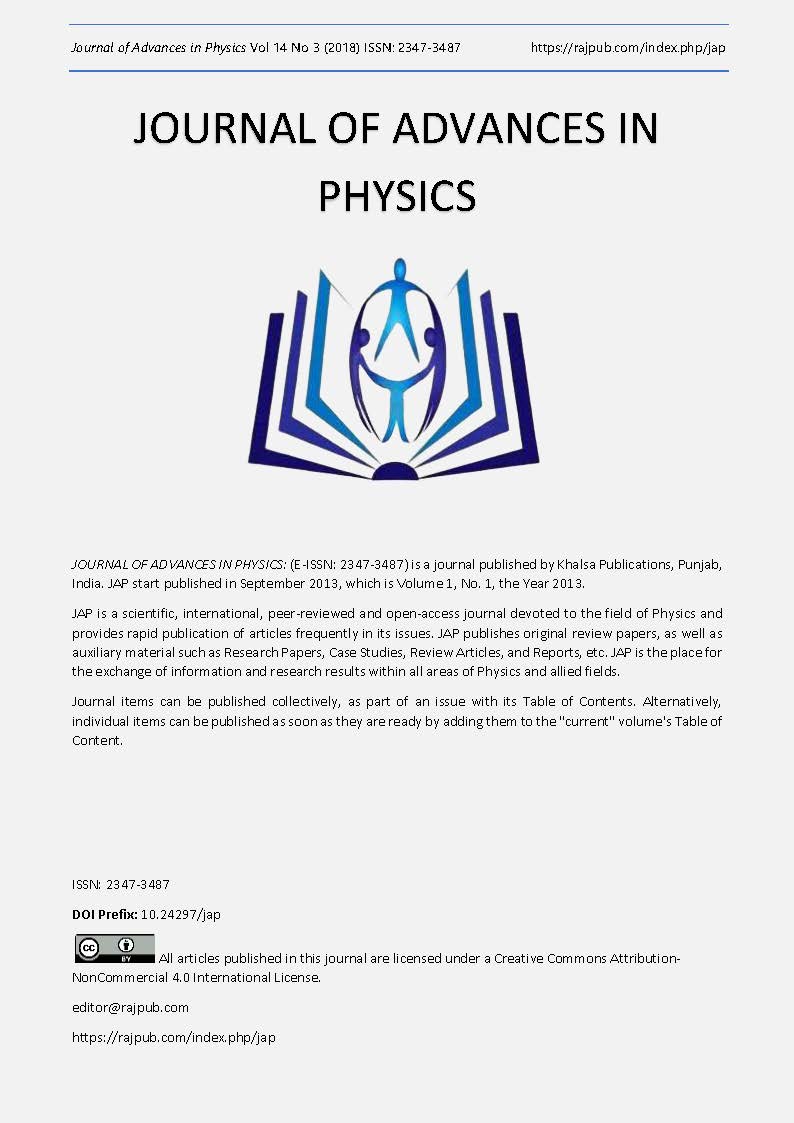Physical Mathematics and The Fine-Structure Constant
DOI:
https://doi.org/10.24297/jap.v14i3.7760Keywords:
fine-structure constant, dimensionless physical constants, history of mathematics, golden ratio, history of physics, mathematical constants, fundamental constantsAbstract
Research into ancient physical structures, some having been known as the seven wonders of the ancient world, inspired new developments in the early history of mathematics. At the other end of this spectrum of inquiry the research is concerned with the minimum of observations from physical data as exemplified by Eddington's Principle. Current discussions of the interplay between physics and mathematics revive some of this early history of mathematics and offer insight into the fine-structure constant. Arthur Eddington's work leads to a new calculation of the inverse fine-structure constant giving the same approximate value as ancient geometry combined with the golden ratio structure of the hydrogen atom. The hyperbolic function suggested by Alfred Landé leads to another result, involving the Laplace limit of Kepler's equation, with the same approximate value and related to the aforementioned results. The accuracy of these results are consistent with the standard reference. Relationships between the four fundamental coupling constants are also found.Downloads
References
Paquette, N. “A View from the Bridge: On the relationship between mathematics and physics,” Inference: International Review of Science, 3, 4 (2018). inference-review.com/article/a-view-from-the-bridge
Moore, G.W. “Physical Mathematics and the Future,” Vision talk, Strings conference, Princeton, 10 (2014). physics.rutgers.edu/~gmoore/PhysicalMathematicsAndFuture.pdf
Gannon, T. Moonshine beyond the Monster: The bridge connecting algebra, modular forms and physics, Cambridge: Cambridge University Press, 2006.
Brézin, E. “Physical Mathematics,” Inference: International Review of Science, 4, 1 (2018). inference-review.com/article/physical-mathematics
Dijkgraaf, R. “Mathematical Structures,” in Henneaux, M., Alexander, S. & Gross, D.J. eds. Quantum Structure Of Space And Time, Singapore: World Scientific, 2007.
Eckert, M. Arnold Sommerfeld: Science, Life and Turbulent Times, New York, NY: Springer, xi, 2013.
Brush, S.G. Making 20th Century Science, Oxford, UK: Oxford University Press, 220, 2015.
Born, M. “The Mysterious Number 137,” Proceedings of the Indian Academy of Science, A 6, 533-561 (1935). www-old.ias.ac.in/j_archive/proca/2/vol2contents.html
Miller, A.I. Deciphering the Cosmic Number, New York, NY: W.W. Norton, 2009.
Sherbon, M.A. “Wolfgang Pauli and the Fine-Structure Constant,” Journal of Science, 2, 3, 148-154 (2012). hal-01304518.
Kilmister, C.W. Eddington’s Search for a Fundamental Theory, Cambridge: Cambridge University Press, 4, 1994.
Kragh, H. “Magic Number: A Partial History of the Fine-Structure Constant,” Archive for History of Exact Sciences, 57, 5, 395-431 (2003). https://link.springer.com/article/10.1007/s00407-002-0065-7
Kragh, H. “On Arthur Eddington’s Theory of Everything,” (2015). arXiv:1510.04046
Whittaker, E. “Eddington’s Principle in the Philosophy of Science,” in Heine, V., Rees, M.J. et al, A.S. Eddington and the Unity of Knowledge, Cambridge: Cambridge University Press, 2013.
Salingaros, N. “Some Remarks on the Algebra of Eddington’s E numbers,” Foundations of Physics, 15, 6, 683-691 (1985). doi.org/10.1007/BF00738296
Eddington, A.S. Fundamental Theory, Cambridge: Cambridge University Press, 1946.
Bekenstein, J.D. “The Fine-Structure Constant: From Eddington’s Time to Our Own,” in Ullmann-Margalit, E. ed. The Prism of Science, New York, NY: Springer, 209-224, 1986.
Durham, I.T. “Sir Arthur Eddington and the Foundations of Modern Physics,” (2006). arXiv:quant-ph/0603146
Rickles, D. “All Possible Perspectives: A (Partial) Defence of Eddington’s Physics,” in Durham, I.T. & Rickles, D. eds. Information and Interaction: Eddington, Wheeler and the Limits of Knowledge, New York: Springer, 2016.
Georgi, H. & Glashow, S.L. “Unity of All Elementary Particle Forces,” Physical Review Letters, 32, 8, 438 (1974), in Froggatt, C.D. & Nielsen, H.B. eds. Origin of Symmetries, Singapore: World Scientific, 1991. doi.org/10.1103/PhysRevLett.32.438
Shaviv, G. The Synthesis of the Elements: The Astrophysical Quest for Nucleosynthesis and What It Can Tell Us About the Universe, New York, NY: Springer, 156, 2012.
Mohr, P.J., Newell, D.B. & Taylor, B.N. “CODATA Recommended Values of the Fundamental Physical Constants: 2014,” Reviews of Modern Physics, 88, 035009 (2016). doi.org/10.1103/RevModPhys.88.035009
Eisen, W. “The Mysteries of the Constants (e) and (i),” in The Universal Language of Cabalah, Marina Del Rey, CA: DeVorss, 160-178, 1989.
Sherbon, M.A. “Quintessential Nature of the Fine-Structure Constant,” Global Journal of Science Frontier Research A, 15, 4, 23-26 (2015). hal-01174786
Sloane, N.J.A. “Polygon Circumscribing Constant,” Sequence A051762 in The On-Line Encyclopedia of Integer Sequences. oeis.org/A051762
Huang, K. Fundamental Forces of Nature, Singapore: World Scientific, 2007.
Sherbon, M.A. “Fundamental Physics and the Fine-Structure Constant,” International Journal of Physical Research, 5, 2, 46-48 (2017). hal-01312695
Weisstein, E.W. “Laplace Limit,” MathWorld. http://mathworld.wolfram.com/LaplaceLimit.html
Heyrovska, R. “The Golden Ratio, Ionic and Atomic Radii and Bond Lengths,” Molecular Physics, 103, 877 - 882 (2005). dx.doi.org/10.1080/00268970412331333591
Heyrovska, R. “Golden Ratio Based Fine Structure Constant and Rydberg Constant for Hydrogen Spectra,” International Journal of Sciences, 2, 5, 28-31 (2013). ijsciences.com/pub/article/185
Sherbon, M.A. “Fine-Structure Constant from Golden Ratio Geometry,” International Journal of Mathematics and Physical Sciences Research, 5, 2, 89-100 (2018). hal-01756341
Landé, A. “Sommerfeld’s Fine Structure Constant and Born’s Reciprocity,” Physical Review, 56, 5, 484 (1939). doi.org/10.1103/PhysRev.56.482.2
Landé, A. “The Structure of Electric Particles and the Number 137,” Physical Review, 56, 5 (1939) in Barut, A.O. & Merwe, A. Selected Scientific Papers of Alfred Landé. New York, NY: Springer, 328, 1988. doi.org/10.1103/PhysRev.56.486
Sherbon, M.A. “Fundamental Nature of the Fine-Structure Constant,” International Journal of Physical Research, 2, 1, 1-9 (2014). hal-01304522
Hagar, A. “Squaring the Circle: Gleb Wataghin and the prehistory of quantum gravity,” Studies in History and Philosophy of Science Part B: Studies in History and Philosophy of Modern Physics, 46, 217-227 (2014). doi.org/10.1016/j.shpsb.2013.07.005
Einstein, A. “On the Method of Theoretical Physics,” Philosophy of Science, 1, 2, 163-169 (1934). doi.org/10.1086/286316
Dirac, P.A.M. “The Relation between Mathematics and Physics,” Proceedings of the Royal Society, 59, 2, 122-129 (1940). doi.org/10.1017/S0370164600012207
Downloads
Published
How to Cite
Issue
Section
License
 All articles published in Journal of Advances in Linguistics are licensed under a Creative Commons Attribution 4.0 International License.
All articles published in Journal of Advances in Linguistics are licensed under a Creative Commons Attribution 4.0 International License.




